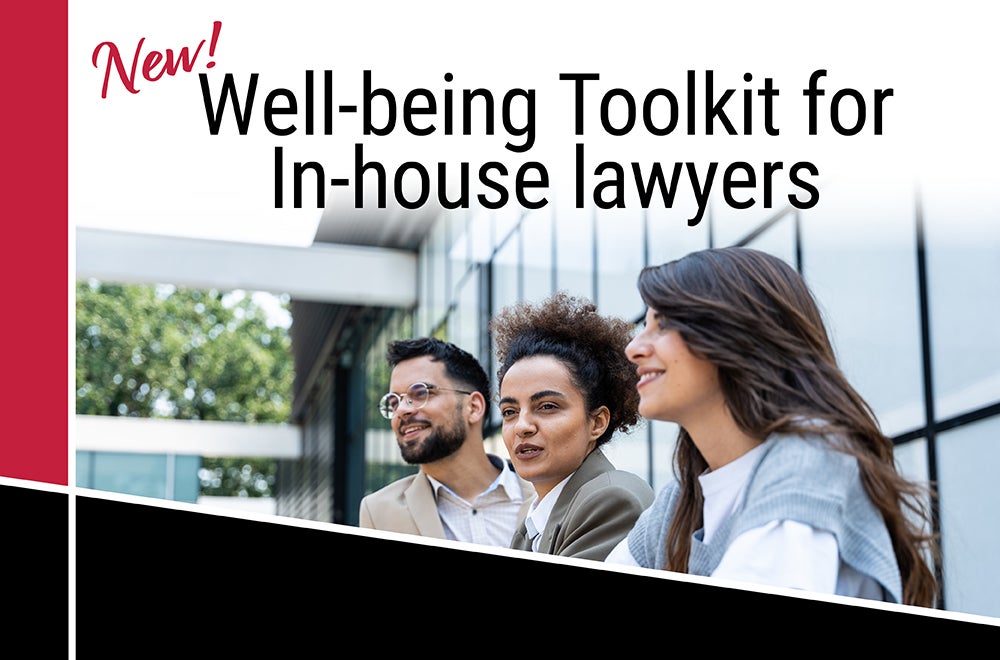Banner artwork by fizkes/ Shutterstock.com
The most important skill a lawyer has is arguably not their technical skills. Rather, it is their ability to get their message across. Whether your audience is business stakeholders, in-house peers, the executive team, or the company’s board, effectively getting your message across is crucial.
It doesn’t matter how long you have taken to prepare, how well you know your subject, or how great your ideas – if your audience is unable to understand your message and action, you have not achieved your goal.

Theo Kapodistrias, general counsel for energy software company Evergen, knows a lot about communication. In addition to being a general counsel, he is a well know MC, coach, and speaker. Kapodistrias recently wrote A Way With Words, which breaks down an effective technique for “crafting and delivering messages that matter” with clarity, conciseness, confidence, creativity, and connection.
Kapodistrias’s book starts with the question: “What is stopping you from moving forward?”
His theories include:
- Feeling uncomfortable speaking up at meetings;
- Writing emails to management and not getting the reply you want or receiving an acknowledgement; and
- Finding your contributions are ignored or other people get credit for your ideas.
We discussed some of his book’s concepts and what it means to be an effective communicator.
Why is clear communication so important for lawyers?
Kapodistrias: Clear communication is an essential skill for lawyers. We have a duty to assist our clients and the business and influence good decision-making. Without providing our advice clearly and in a format that is easy for our stakeholders to pick up and understand, we will struggle to be heard.
What are some tips when thinking about your difference audiences (directors, stakeholders in the business)?
It’s always critical to consider who the audience is, what information they already know, what they need to know, and how best to deliver this information.
A tip that should apply to everyone collectively is that plain English should be used to ensure that you’re not confusing anyone with complicated concepts, and instead using language which can be picked up and understood instantly.
It's always critical to consider who the audience is, what information they already know, what they need to know, and how best to deliver this information.
What are some tips when trying to get your message across to an executive or board member quickly?
If you know them and how they like to receive information, you can communicate a message using that format.
If you’re not sure, perhaps considering different ways to communicate can be useful such as a short audio message, using a system like Loom to record a video and share your screen at the same time, or a more traditional format such as an email with the most critical information presented at the top and additional details below.
How do you manage to get your message across to someone who isn't listening or is refusing to listen to what you have to say?
If someone doesn’t want to hear what you have to say, or when they may be angry, it’s important to try and get them to understand why it’s important for them.
As a lawyer, you want to make sure that there is a reason behind why you’re saying what you’re saying – making this clear will mean the other person should stop and pay attention.
What are some of the ways you can build your confidence? What can people do who are not confident by nature?
Confidence is something that builds over time. We don’t wake up one day and say, “I’m confident.” Confidence builds once we can prove that we can do it. It’s important to start by reminding ourselves that we should have confidence in our message because we’re the right person to be speaking on this based on our experience, our knowledge, and our work.

In the presentation space, you can start by doing presentations to smaller groups and then keep on building this until you feel more comfortable to speak.
Using social media can help too. Pop onto an Instagram live and chat to people and see what happens.
It's important to start by reminding ourselves that we should have confidence in our message because we're the right person to be speaking on this based on our experience, our knowledge, and our work.
What do you do if presenting to a room and a few people are not listening or actively speaking?
There are handy engagement tips that can help to bring people along for the journey. Using interactive elements can help to bring the discussion to life and engage your audience a little more. Using polling questions can help get people involved and then opening up a discussion about the answers can allow people to feel more invested in what’s happening.
How do you prepare for a presentation?
I have a presentation preparation process which I teach to people and use myself:
- Research and prepare – Understand your subject matter as best as you can as well as the audience you’ll be speaking with.
- Your main points – Understand the key message you want to share, and then identify the three key points to articulate the message.
- Illustrate those points – Provide appropriate information from a factual perspective such as statistics and number as well as presenting it in an illustrative way through stories, images, and videos to showcase a fully formed concept for your audience to appreciate.
- Create your materials – Once you’re clear on the message and the points, you can start to compile your materials such as a slide deck.
- Practice – You need to be familiar with your material and comfortable with what you’re sharing so it’s important to practice and have a go.
- Record yourself – Record yourself and watch and listen back to the recording to identify the things you liked and the things you want to improve. Implementing those, go back and record yourself again and keep reviewing the material.
- Do it! Now that you’ve done the work, you need to prove to yourself that it can be done.
Your book mentions AIDA – what is it and how do you make this work for you?
AIDA is a marketing technique developed by advertising and sales expert Elias St Elmo Lewis and is an acronym for attention, interest, desire, and action.
When we provide legal advice and you want your reader to pay attention, capturing their attention initially will be critical. Using a shocking statistic or outlining the potential fines may be a necessary eye-opening start to gain attention.
Being able to then maintain interest is important. Sharing the information in clear, concise, and plain English as well as how the information is presented will go a long way to keep the interest of the reader. Using dot points to outline critical issues and advice makes it easier to follow and read.
The desire section is where you could consider the value proposition of what you’re talking about – i.e., perhaps it’s about a new piece of legislation and this is where you can demonstrate the importance that complying can have internally and the improvement on existing processes it could make.
The final piece is action. What are you expecting someone to do as a result of reading this advice? With everything, you want to be able to provide a way forward for your advice to be as beneficial as possible. You want to give your reader a call to action to make something happen.
Connection is a pillar of your book and you mention the Chris Anderson – why does this resonate with you?
Anderson (or TED conferences) was quoted in my book as saying, “Be yourself. The worst talks are the ones where someone is trying to be someone they aren’t. If someone is goofy, then be goofy, If you are emotional, then be emotional.”
Chris Anderson’s quote is so critical to me, and I think about it regularly with all forms of communication.
As lawyers, if we don’t show any personality or show who we are as people, we will struggle to get the buy-in from the business as we may appear to be speaking down from our ivory tower. If we’re able to be ourselves, speaking in a way that is natural for us and that isn’t full of legalese and technical legal talk, and providing useful and practical advice, we’ll be appreciated as both a person and a lawyer.

How do you build trust and connection with someone new and how can you regain it with someone where it has been lost?
Giving someone your full attention and demonstrating that you’re listening will be essential for helping to build a level of connection and trust. You need to show some empathy and that you care – put your phone away, give the person eye contact, and actively listen to what they’re saying to you. People want to get to know the real you as well – if you can show who you are and engage in a conversation like a person (and not a lawyer), you’ll find it much easier to build a stronger connection and trust with others around you.
Giving someone your full attention and demonstrating that you're listening will be essential for helping to build a level of connection and trust.
Frances Frie delivers an amazing TED Talk about how to build and rebuild trust. She outlines that trust has three elements: authenticity, logic, and empathy, and together this leads to a relationship of trust. If there is a wobble with one, or more of these elements, trust can be broken. You’d need to identify which element has broken and then try and rebuild from there – i.e. – did you provide advice that may have alternative views and perspectives, but you didn’t fully explain your logic behind why you advised how you did?
Trust may diminish in these circumstances. But you could follow up with further explaining your logic and reasoning behind the advice so that your client can understand your perspective a little clearer.
A way with words
A lawyers’ role is to be technical and get to the right answer, but in-house lawyers need to do more – we need to get the message across and do so successfully in order to help influence an outcome or properly explain the risks to a stakeholder.
We may want to share knowledge during a presentation and concisely present to the board. To do this we need to have a way with words – to understand what it means to be clear and confident and find creative ways to get our message across.
Disclaimer: The information in any resource in this website should not be construed as legal advice or as a legal opinion on specific facts, and should not be considered representing the views of its authors, its sponsors, and/or ACC. These resources are not intended as a definitive statement on the subject addressed. Rather, they are intended to serve as a tool providing practical guidance and references for the busy in-house practitioner and other readers.




